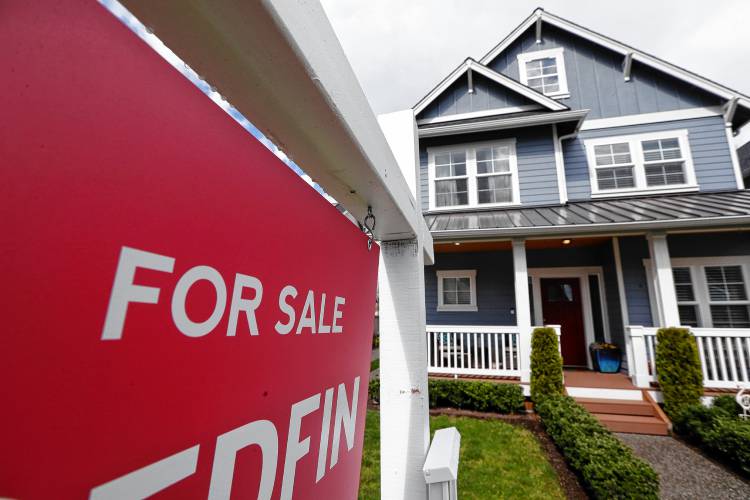NH single-family home median price tag hits $500,000

Elaine Thompson/AP file photo
| Published: 04-25-2024 10:11 AM |
The median sales price for an existing single-family home in New Hampshire hit the $500,000 mark in March, with condo/townhouse properties following close behind at $409,950.
Despite the record-high prices, sales edged up slightly in the state, according to the monthly New Hampshire Association of Realtors market report.
The New Hampshire median sales price for an existing single-family home in March was well above the national MSP of $384,500. Median means that half of the properties sold for more, and half for less.
The high prices for single-family homes are accompanied by a near all-time low affordability index of 59. That means that the median New Hampshire income is 59% of what is needed to pay the monthly costs of a median-priced home, including mortgage payment with interest, property taxes and insurance. The lowest the affordability index has been was 58 in October. In March 2023, it was 70.
It’s also becoming increasingly difficult for New Hampshire residents to afford a condo/townhouse property, traditionally the lower-priced alternative to buying a house. The affordability index for the condo/townhouse market was 73 in March. Condo/townhouses, a much smaller market than single-family homes, gained 16.7% in inventory from a year ago, increasing from 1.2 month’s inventory to 1.4. That means if all the properties for sale on the market sold at the current pace, with none added, it would take 1.4 months. Industry experts say a 4 to 6 month inventory is ideal.
Single-family home buyers paid 101.2% of list price in March, up from 100.5% a year ago. Condo/townhouse buyers paid 101.3% of list price, up from 100.8% a year ago. Single family homes sold in March spent 34 days on the market, as opposed to 38 a year ago. Condo/townhouse properties spent 31 days on the market, as opposed to 39 a year ago.
Inventory for single-family homes in New Hampshire increased 9.1% over last March, from 1.1 to 1.2. The last time it was that low was April 2023. After that, inventory climbed to 2.0 in September and October before declining, dropping to 1.2 in February. Even so, March’s inventory shows a marked improvement over March 2022, when it was 0.9.
Single-family home pending sales were up 10.6% from March 2023; condo/townhouse pending sales were up 4.3% from this time last year.
Article continues after...
Yesterday's Most Read Articles
 Update: Reactions for, against the more than 100 arrested at Dartmouth, UNH
Update: Reactions for, against the more than 100 arrested at Dartmouth, UNH
 Franklin police arrest man after accidental shooting Wednesday
Franklin police arrest man after accidental shooting Wednesday
 Opinion: New Hampshire, it’s time to acknowledge the stories of suffering
Opinion: New Hampshire, it’s time to acknowledge the stories of suffering
 Baseball: Merrimack Valley now 6-1 following wild game at Pembroke Academy
Baseball: Merrimack Valley now 6-1 following wild game at Pembroke Academy
 Food insecurity on the rise in N.H.
Food insecurity on the rise in N.H.
 Concord High graduate leads Pro-Palestine protests at Brown Univeristy
Concord High graduate leads Pro-Palestine protests at Brown Univeristy
Even so, new listings decreased 0.7% for single-family homes and 2.4% for townhouse-condo properties. There were 699 closed sales across the state in March, a slight drop from 715 in March 2023. There were 308 closed condo/townhouse sales, compared to 282 in March 2023.
There were 966 new single-family home listings in March, up from 973 a year ago. There were 364 condo/townhouse new listings in March, down from 373 a year ago.
Nationally, sales were up 9.5% for existing single-family homes, the second month in a row there was an increase. The increase exceeded economists’ expectations and marked the largest monthly gain in a year, according to the National Association of Realtors.
“The rebound in home sales comes amid fluctuating mortgage rates and elevated sales prices, indicating there is plenty of buyer demand heading into the spring selling season,” the NHAR report said.
“The recent [national] surge in home sales was likely due to a dip in mortgage rates in December and an increase in housing supply nationwide,” the NHAR said. Nationally, total inventory grew 5.9% month-over-month and 10.3% year-over-year to 1.07 million units, for a 2.9 months’ supply at the current


 New Hampshire jury finds state liable for abuse at youth detention center and awards victim $38M
New Hampshire jury finds state liable for abuse at youth detention center and awards victim $38M Jurors hear closing arguments in landmark case alleging abuse at New Hampshire youth center
Jurors hear closing arguments in landmark case alleging abuse at New Hampshire youth center Voice of the Pride: Merrimack Valley sophomore Nick Gelinas never misses a game
Voice of the Pride: Merrimack Valley sophomore Nick Gelinas never misses a game
